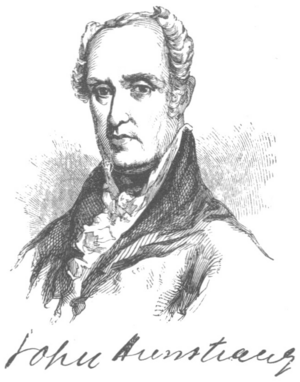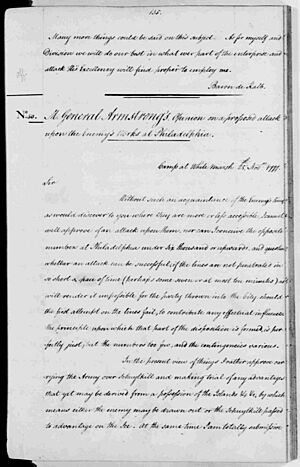John Armstrong Sr. facts for kids
Quick facts for kids
John Armstrong
|
|
|---|---|
 |
|
| Member of the Continental Congress | |
| In office 1779–1780 |
|
| Personal details | |
| Born | October 13, 1717 Brookeborough, Fermanagh, Ireland |
| Died | March 9, 1795 (aged 77) Carlisle, Pennsylvania, U.S. |
| Spouses |
Rebecca Lyon
(m. 1747; |
| Children | James Armstrong John Armstrong Jr. |
| Parents | James Armstrong Jane Campbell |
| Military service | |
| Branch/service | Continental Army |
| Rank | Brigadier general |
| Battles/wars | Seven Years' War: • Battle of Kittanning • Forbes Expedition American Revolution: • Battle of Brandywine • Battle of Germantown |
John Armstrong (born October 13, 1717 – died March 9, 1795) was an important American leader. He was a civil engineer and a brave soldier. During the American Revolutionary War, he served as a brigadier general in the Continental Army. He was also a major general in the Pennsylvania Militia. Armstrong was a delegate for Pennsylvania in the Continental Congress. Armstrong County, Pennsylvania is named after him to honor his contributions.
Contents
Early Life and Education
John Armstrong was born on October 13, 1717, in Brookeborough, County Fermanagh, Ireland. He was one of about 15 children in his family. His parents married in 1704. Some of his siblings included Margaret Armstrong and Rebecca Armstrong.
John received his education in Ireland. He became a civil engineer there. Around 1740, he moved to Pennsylvania. He traveled with his brother-in-law, John Lyon.
Career as a Surveyor and Soldier
Armstrong first came to Pennsylvania as a surveyor. He worked for the Penn family, who owned the colony. In 1750, he designed the first layout for the town of Carlisle, Pennsylvania. He was also one of the first people to settle there. Later, he became the official surveyor for the new Cumberland County.
Fighting in the Seven Years' War
Armstrong was a military leader during the Seven Years' War. In 1756, he led a group of soldiers on the Kittanning Expedition. This was an important mission.
In 1758, Colonel Armstrong led 2,700 Pennsylvania troops. They were part of the Forbes Expedition. Their approach made the French army leave and blow up Fort Duquesne. Armstrong became good friends with another military leader on this trip, Colonel George Washington.
In the fall of 1763, Armstrong led a campaign against Native American groups. They burned towns and destroyed corn supplies.
Role in the American Revolution

When the American Revolutionary War began, Armstrong was a brigadier general. He served in the Pennsylvania militia. On March 1, 1776, the Continental Congress gave him the same rank in the Continental Army. He was sent south to help prepare defenses for Charleston, South Carolina.
Armstrong used his engineering skills to build strong defenses. These defenses helped Charleston survive the Battle of Sullivan's Island later that year. After General Charles Lee arrived to take command, Armstrong returned to his duties. He worked with the main army and the Pennsylvania militia. Pennsylvania then made him a major general in charge of the state militia. This ended his time in the Continental Army, but he continued to work with General George Washington.
Battle of Brandywine
On September 11, 1777, the Battle of Brandywine took place. Armstrong's militia held the far left side of the American battle line. They also protected the army's supplies. After a tough day of fighting, the Americans had to retreat. Armstrong successfully moved the supplies and his militia away from Pyle's Ford after dark.
Battle of Germantown
At the Battle of Germantown on October 4, General Armstrong led the American right side. His job was to go around the British left side and attack them from behind. Even with some delays, the attack started well. However, the American center got stuck at the Benjamin Chew House.
The attack then fell apart. There was a friendly fire incident in the fog. General Adam Stephen's men accidentally shot at Anthony Wayne's troops. This caused Wayne's troops to retreat. Armstrong's men had advanced close to the center of Germantown. They were not heavily involved in the main fight. Armstrong later said it was "....a glorious victory fought for and eight tenths won, ....mysteriously lost." He felt no one could explain why they lost.
After the Battle of Germantown, Armstrong was allowed to leave active command. He was sixty years old, and his health was not good. Old wounds were also bothering him. He served until April 4, 1778.
Later Life and Public Service
After the war, Armstrong went back home to Carlisle. The Pennsylvania Assembly elected him to the Continental Congress. He served as a delegate from 1779 to 1780. During this time, he strongly supported George Washington and the army.
Armstrong firmly supported a new United States Constitution. He was also part of the Congress of the Confederation in its final years, from 1787 to 1788.
Throughout his life, Armstrong held many local public offices. He was on the Carlisle school board. At first, he was against Dr. Benjamin Rush's idea to start a college in the town. But he later changed his mind. He became a member of the first Board of Trustees for Dickinson College. He served there from 1783 to 1794.
Family and Legacy
In 1747, John Armstrong married Rebecca Lyon Armstrong (1719–1797). They had two sons:
- James Armstrong (1748–1828), who married Mary Stevenson.
- John Armstrong Jr. (1758–1843), who married Alida Livingston. She was the sister of Robert R. Livingston and Edward Livingston.
John Armstrong passed away at his home in Carlisle, Pennsylvania, on March 9, 1795. He is buried in the Old Carlisle Cemetery. In 1800, Pennsylvania created a new county. Its main town was Kittanning. This new county was named Armstrong County in his honor.
Images for kids


